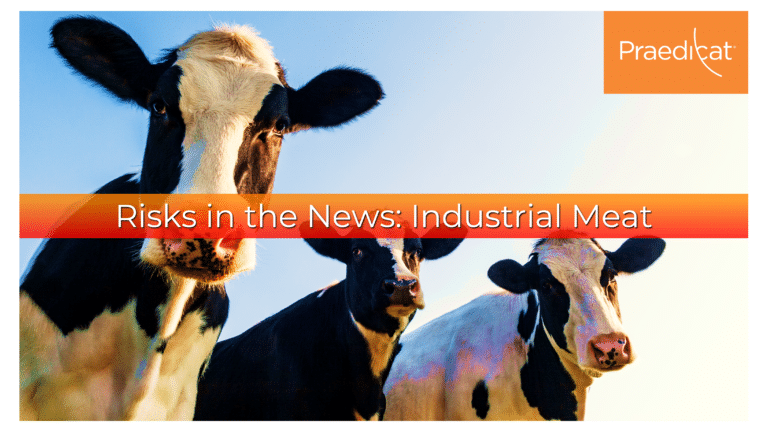Praedicat Blog – Industrialized meat production is hurting
the climate, our health, and maybe your portfolio
by Adam Grossman & Sheryll Mangahas
“Beef. It’s what’s for dinner.” Many of us remember that 1990s advertising campaign, designed to remind us all about the supposed benefits and enjoyment of eating beef. Given how our understanding of the costs – both to our health and the environment – of eating beef have evolved it seems more likely that advocacy groups would come up with a slogan along the lines of: “Beef. It causes climate change!”
As our clients know, Praedicat is building a climate liability suite consisting of a package of scenarios and Litagion® agent profiles describing several climate risks that could manifest as liability events. Our diesel emissions scenario was the first release in this analysis suite and we’ve recently released a scenario exploring how the industrialization of raising animals for food – “industrial meat” – could lead to large liability events.
The concerns with industrial meat are two-fold: the health consequences of eating meat and the environmental consequences of industrial farming practices to raise the animals that become meat.
The health problems associated with eating large quantities of meat, especially red meat, have been known for a long time. As long as 20 years ago, scientists were in general agreement that those who consumed large quantities of red meat were at significantly higher risk of developing gastrointestinal cancers, especially colorectal cancer. More recently, scientists have broadened their focus to include cardiovascular disease, including ischemic heart disease, and type II diabetes. While consensus has not yet been reached on these other hypotheses that red meat consumption can cause human harm, our projections suggest that there is a possibility they become strong enough to support litigation in the next decade.
Although the causal links between chronic disease and meat consumption are in various stages of gaining scientific acceptance, the climate impact of raising animals for food, particularly in industrial settings, is no longer up for debate. All animals expel carbon dioxide as they breathe, and release methane as they ferment food in their guts. Ruminant animals, because they digest their food multiple times, release significantly more methane than their non-ruminant brethren. Coupled with the fact that cows need to be raised far longer than chickens (for example), raising one pound of beef emits between 4 and 10 times as much greenhouse gas than similar amounts of chicken, about half of which is from methane.
Methane presents a unique problem for the climate because it is 80 times more powerful than carbon dioxide at trapping heat in the atmosphere in the short term, before it eventually breaks down into carbon dioxide and other chemicals. This unique property of methane has led scientists to estimate that eliminating methane emissions would get us most of the way to achieving our short-term goals on global warming. This also sets up industrial meat operations, where greenhouse gas emissions are most concentrated, as perfect villains in a potential litigation.
The issues with industrial meat production don’t end at methane, though. The combination of intensive use of fertilizers to grow food for these animals, the millions of tons of animal waste, and large amounts of antibiotics fed to these animals to keep them healthier (and make then grow more quickly) presents a host of environmental issues that the broader environmental movement wants to solve. This confluence of factors led us to develop a scenario combining litigation directed at the climate nuisance created by industrial meat farming alongside trying to recover the significant expenses incurred by state Medicaid programs to treat those with chronic disease linked to meat consumption.
The industries that could be held responsible for the climate and heath harms vary significantly depending on the legal theories that plaintiffs press in court and their success. If liability falls mainly on the direct emitters of greenhouse gasses, much of the agriculture industry, both animal and animal feed farming, would be under the gun. On the other hand, many of the farmers who grow the animals are doing so at the direction of the large meat processing companies. This leads to the possibility that liability falls to them based on their control of the animal farming stream of commerce, leading what we call “big meat” to take the lion’s share of the loss. As we’ve seen in the opioid litigation, sometimes those who distribute and sell harmful products are also held responsible, so we’ve included a scenario where the same thing happens to the industrial meat stream of commerce, which then brings in grocery stores, meat markets, fast food restaurants, and the processed food industry.
Part of preparing for the inevitable onslaught of climate litigation requires insurers and their emerging risk modelling providers to think broadly about how climate change can manifest in liabilities that reach the insurance industry. Praedicat’s climate-related scenarios are the perfect starting point for managing this risk, and the two we have published to date are the first of ten that we plan to release over the coming months.
Contact a member of our team to talk about our emerging interest risks


